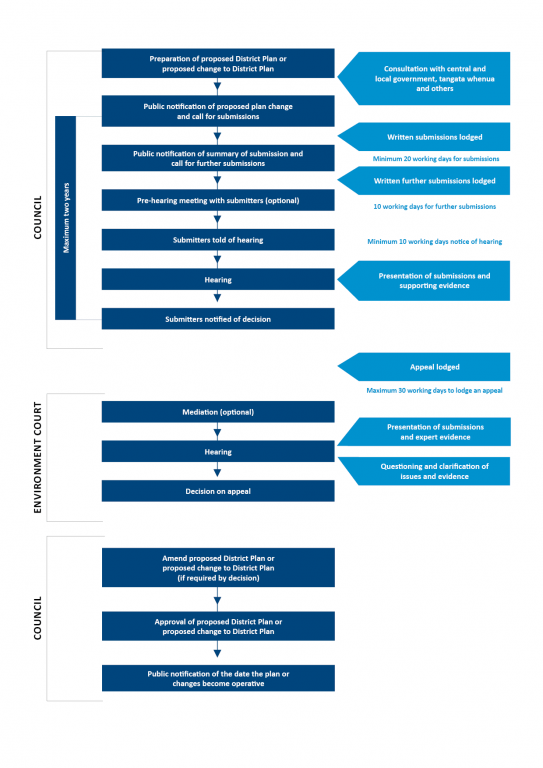A plan change is a change to a District Plan. This is a public process, which means it requires research, evaluation and is required to go through public notification, submissions and hearings processes, including the right of appeal to the Environment Court.
A plan change can be initiated by Council or by members of the public through a private plan change. Examples of possible plan changes include:
- rezoning of land
- implementing Government directions
- amendments to rules
- addition of a building to the schedule of heritage buildings.
Frequently Asked Questions
Why do councils undertake plan changes?
The Resource Management Act 1991 (RMA) requires requirements in the Plan to be reviewed every 10 years. However, it is best practice for the Plan to be reviewed regularly to monitor its effectiveness and if we need to, we will initiate a plan change to respond to any emerging issues.
What does the plan change process involve?
The RMA outlines a process which we must follow. Community involvement, including pre-engagement, consultation, notification, submissions and hearings are all important steps in the process.
There are currently three pathways a plan change could fall under:
- The standard consultation (default) pathway. This involves consultation and community engagement, including pre-consultation, notification, submissions, decisions and appeals to the Environment Court.
- The limited notification pathway. This is the same as the default pathway, except that only directly affected landowners or parties are notified. This is usually for localised or very specific plan changes.
- The streamlined planning process (SPP) pathway. This is where Council applies to the Minister for the Environment for a fast-track plan change. The standard process and timeframes can be modified, and the Minister makes the final decision rather than Council.
What do I need to know about the plan change process?
- We will engage with those affected by the proposed plan change before notifying (giving formal notice).
- The level of consultation required will depend on the nature of the plan change.
- We will produce a plan change document that includes an explanation of the proposed changes and a “section 32” report (a framework for the evaluation reports about the changes). This report looks at the appropriateness of the plan change and assesses the costs and benefits of the environmental, economic, social and cultural effects anticipated from the plan change.
- When a plan change is notified any member of the public can make a submission in writing on the prescribed form. Here submitters can explain why they support or oppose the plan change.
- The submission process needs to be open for at least 20 working days.
- Once all submissions are received, they are summarised and ‘notified’.
- Certain people can make further submissions in writing on the prescribed form. Further submissions cannot identify new issues but can support or oppose the contents of original submissions. Further submissions are called for over a period of at least 10 working days.
- The Council will then hold a Hearing (if required), so submitters can verbally present their submissions. At this meeting there will be a Hearing Panel which is made up of councillors, independent commissioners, or a mix. After the Hearing the Council then decides to accept or reject each submission received in whole or in part. The Council will then publicly notify its decision.
- A submitter can appeal the Council decision to the Environment Court within 30 working days. If you are considering lodging an appeal on a plan change it is recommended that you obtain independent legal advice.
Plan changes and legal effect
In general, proposed plan changes have legal effect when decisions on submissions are publicly notified. Some specific exceptions apply under sections 86A to 86G of the RMA
In addition to the existing rules within the District Plan, resource consents must be applied for activities that trigger new rules that have legal effect within proposed Plan Changes. In other words, different resource consents may be required under both the existing rules and the new rules.
What should I think about when making a submission?
The following tips are useful when making submissions. Ensure that you use the appropriate form provided and:
- Make your thoughts clear and easy to read.
- Include your contact details.
- Identify whether you wish to speak at the hearing or not.
- Identify if you support or oppose the plan change. If you support part or oppose part, state which parts.
- Detail the specific part of the District Plan your submission is about.
- Be specific and clear about what outcome you want. If you want a rule changed, state what you want changed about it and provide alternative wording or suggestions.
- Your submission should not include any issues not relevant to the plan change as these will not be able to be considered by the Council when making its decision.
Please note your submission, including your personal information, will be publicly available as part of the Council’s decision-making process.
